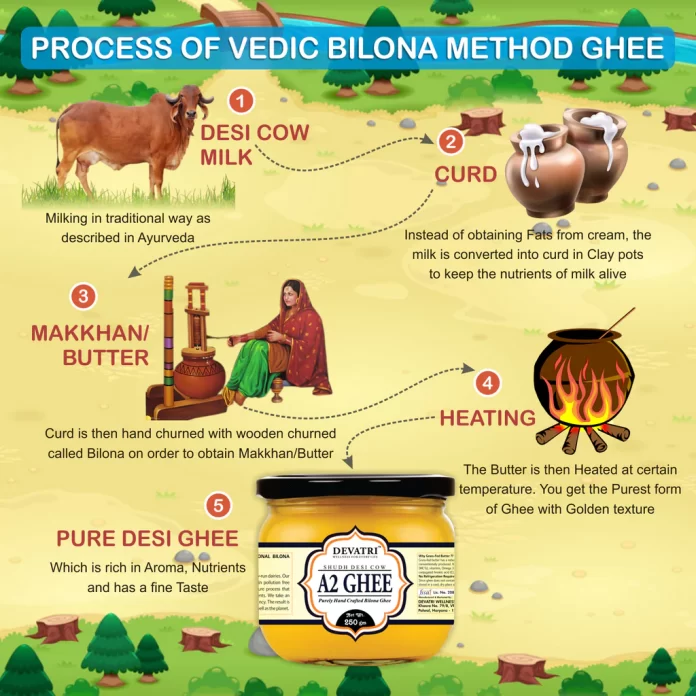Why the best kind of ghee is A2 ghee, and why should people avoid ingesting ghee that is mass-produced by businesses that are easily accessible? Even though it may be challenging to understand, what we are eating is not the same as the ghee our forefathers ingested in the past. The ghee sold in supermarkets under the names “Cow Ghee,” “Unadulterated Ghee”, or “Cow’s Desi Ghee” isn’t even produced using conventional methods.
So how can you differentiate between pure A2 desi cow ghee and impure ghee manufactured in the market? Here are some pointers to identify.
How to Verify the Genuineness of A2 desi cow ghee?
Food product pollution is a significant issue on a global scale. Brands engage in such acts of negligence and risk the welfare of customers to satisfy their needs. Ghee is often mixed with almond oil, coconut oil, and hydrogenated oils like vanaspati to increase its volume. Here are several easy techniques for verifying A2 desi cow ghee’s validity at home.
- Colour test: Melting A2 cow ghee in a pan is the simplest and fastest way to determine its purity. A tablespoon of A2 ghee should be added to the pan after it has warmed up for a while over a medium temperature on the gas burner. In the rare scenario that perhaps the ghee immediately melts and develops a dark brown shade, it is pure A2 cow ghee. On the other hand, your ghee is damaged if it takes a while to melt and turns a pale yellow colour rather than brown.
- Double boiler method: Using this technique, you may determine whether or not your desi cow ghee has already been contaminated with coconut oil. This approach requires you to add ghee to a glass dish and use the double-boiler technique to melt it. Then, immediately pour the mixture into a jar and keep it in the fridge for a bit. In the unlikely event that now the coconut oil with A2 ghee eventually forms distinct layers, your A2 ghee has been tainted with coconut oil. The A2 desi cow ghee is genuine if it doesn’t divide into separate layers as it solidifies.
- Palm test: The palm test is an additional way to determine whether A2 ghee is real. Results will be available in a matter of seconds using this quick and easy procedure. To use this technique, put a spoonful of A2 desi cow ghee on the palms and hold it there for a short while. Ghee is considered to be A2 and pure if it begins to melt. On the other hand, ghee is contaminated if it doesn’t melt immediately and takes a long time.
- Sugar test: Using this technique, you may determine whether or not the A2 ghee has already been contaminated with vegetable oil. This approach requires adding ghee and a small sugar to a glass jar. Then, shake the liquid vigorously for a brief period after tightly sealing the container’s lid.
Maintain the combination for at least 5 minutes. If a crimson hue begins to form at the bottom of the jar after five minutes, the ghee is contaminated and has been tainted with vegetable oil. The ghee is A2 desi cow ghee and pure if it doesn’t change colour and remains the same.
- Iodine test: You may determine whether or not your A2 cow ghee has been contaminated with starch (mashed potatoes) using this technique. Add some melting ghee and a few drops of iodine to a glass jar to use this procedure. Shake the liquid vigorously for a brief period after tightly sealing the bottle’s lid. Then, for two to three minutes, set the mixture away.
If the liquid turns purple within a few minutes, your ghee is impure and has starch in it. The ghee is A2 desi cow ghee and pure if the colour doesn’t alter and remains the same.
- Chemical testing: This method uses a few chemical substances to examine adulteration. Before using these substances, make sure you are prepared with protection devices. Heat a test tube with a spoonful of ghee added to it. Add similar amounts of strong HCl and a dash of sugar right now. To combine the substance, stir the test tube. If pink or red-coloured granules appear in the bottom layer, the ghee has likely been contaminated with old ghee, such as vanaspati ghee.
Conclusion
The texture of A2 desi cow ghee made from the pure milk of A2 cows is semi-solid. This is because the correct ratios of long- and short-chain saturated fatty acids are present in ghee made from A2 cow milk. On the other hand, if purified A2 milk isn’t used to make the ghee, it will either be hard or watery. Therefore, you can determine quickly if the ghee you purchased is pure by using the above-listed technique and evaluating it at home.
